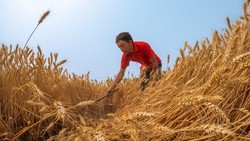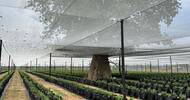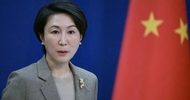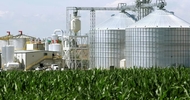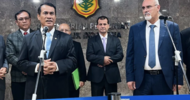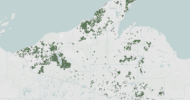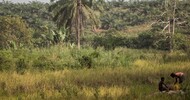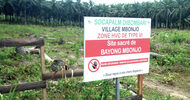Dim Sums | 13 May 2018
China adjusts "Go Global" agriculture program
China's foreign investment and cooperation in agriculture must recognize the "deep changes in the domestic and foreign environment," "seize opportunities" and "take the initiative" according to exhortations issued at a Ministry of Agriculture and Rural Affairs meeting of officials responsible for international cooperation held last week.
Officials were instructed to guide industries to shift investment to "belt and road" countries and the Indochina region of Southeast Asia. Other edicts were to:
- establish a complete agricultural trade policy system,
- actively participate in negotiations on international rules for trade and investment.
- speed up nurture of a set of major international grain traders and agricultural enterprise conglomerates,
-
encourage enterprises to optimize their industry and market layout worldwide.
The meeting chaired by Minister Han Changfu carefully studied Xi Jinping's thoughts on "rural revitalization" and "one belt, one road" and propagated the themes of building an "open agricultural economy" and international competitiveness in agriculture. According to the Ministry, better coordination of investment and developing a complete policy system improving policy support for overseas investment and technical assistance to continually improve agriculture’s international competitiveness and global influence will "add luster to the modernization of agriculture and rural areas."
There is nothing really new in last week's meeting. All the components have been included in China's recent under-the-radar program to make the country's overseas agricultural investments more effective.
A November 2016 Ministry of Agriculture circular "Program for Construction of 'Two Zones' for External Agricultural Cooperation" laid out an experimental program for trying out various support and development strategies for foreign investors in agriculture to carry out instructions in the State Council's "No. 1 Documents" to improve international cooperation in agriculture with "one belt, one road" countries and foster big grain traders and agribusiness conglomerates. Participating companies can be both state-owned and private, and non-agricultural companies are also encouraged.
In a two-year pilot program the strategy will throw different ideas at the wall and see which one sticks. "Two zones" refers to foreign "demonstration zones" and "experimental zones." Demonstration zones include various types of technology and industry parks and free trade zones with an emphasis on multiple Chinese businesses working together to form industry clusters and/or chains of industry: seeds, machinery, farming, marketing, processing and sales. "Experimental zones" are zones in China that will experiment with various policies to provide support to overseas investors in agriculture, including information databases, subsidized loans, insurance, training of companies and personnel. Companies could get help raising funds in capital markets, loan guarantees, priority in attaining national-level "dragon head enterprise" status, help with inspection and quarantine procedures. The document called for state-trading enterprises to use their tariff rate quotas to import products of Chinese companies investing in agriculture abroad.
Last July, the first ten demonstration and experimental zones were announced, and the top 100 overseas agricultural investment companies were announced in February 2018. Lists are shown below.
The first 10 demonstration zones included five in Africa, two in central Asia, two in southeast Asia, and a fishing industry zone in Fiji. The Tanzanian zone happens to be in a gold-mining region. Each zone is to be managed by a relatively anonymous provincial company:
| First set of Chinese foreign agriculture development zones, announced July 31, 2017 | |
| Zone name | Company responsible |
| Tajikstan-China Agricultural Cooperation Demonstration Park | Xinjiang Lihua Cotton Co. |
| Mozambique-China Agricultural Technology Demonstration Center | Hubei Province Lianfeng Overseas Agriculture Development Ltd Co |
| Jiangsu-Shinyanga Agricultural and Industrial Modern Industrial Park (Tanzania) | Jiangsu Haiqi Technology Engineering Ltd Co |
| Uganda-China Agricultural Cooperation Industry Park | Sichuan Youhao Hengyuan Agriculture Development Ltd Co |
| Star of Asia Agricultural Industry Cooperation Zone (Kyrgyzstan) | Henan Guiyou Shiye Group Ltd Co |
| Sudan-China Agricultural Cooperation Open Zone | Shandong International Economic Technology Cooperation Co |
| Laos-China Modern Agricultural Technology Demonstration Park | Shenzhen Huada Genetic Sci-tech Ltd Co |
| Cambodia-China Tropical Ecological Agricultural Cooperation Demonstraton Zone | Hainan Dingyi Luzhou Ecological Agriculture Ltd Co |
| Fiji-China Fishery Industry Comprehensive Industry Park | Shandong Lidao Ocean Technology Ltd Co |
| Zambia Agricultural Product Processing Cooperation Zone |
Qingdao Ruichang Sci-Tech Industry Ltd Co |
Experimental zones include a mix of port cities, fishing industry centers, inland border crossings, a China-Singapore food trade zone, and a tropical agriculture institute, most managed by city or county governments.
| China Open Agriculture Experimental Zones, announced July 31, 2017 | |
| Zone name | Organizing Unit |
| Qionghai Open Agriculture Cooperation Experimental Zone | Hainan Qionghai City Government |
| Tropical Agriculture Open Cooperation Experimental Zone | China Institute for Tropical Agriculture |
| Lianyungang Open Agriculture Cooperation Experimental Zone | Jiangsu Lianyungang City Government |
| Jilin Zhongxin Food Zone Open Agriculture Cooperation Experimental Zone | Jilin (China-Singapore) Food Zone Management Commission |
| Jeminay Open Agriculture Cooperation Experimental Zone | Xinjiang AR, Jeminay County Government |
| Raoping Open Agriculture Cooperation Experimental Zone | Guangdong Province, Raoping County Government |
| Weifang Open Agriculture Cooperation Experimental Zone | Shandong Weifang City Government |
| Dongning Open Agriculture Cooperation Experimental Zone | Heilongjiang Dongning City Government |
| Rongcheng Open Agriculture Cooperation Experimental Zone | Shandong Rongcheng City Government |
| Binhai New District Open Agriculture Cooperation Experimental Zone |
Tianjin Binhai District Government |
A partial list of the top 100 companies designated for foreign investment in agriculture includes the top state-owned grain-trader COFCO, the top agribusiness conglomerate Guangming, many companies from the system of state farms, state-owned chemical companies, feed, seed, agricultural machinery, rubber, and fishery companies.
| Sample list of 31 of the top 100 Chinese companies for foreign investment in agriculture, February 2018 |
| COFCO Group |
| Guangming Foods |
| Hainan Natural Rubber Industry Group |
| New Hope Liuhe Corporation |
| Shandong Ruyi Sci-Tech Group |
| Sinochem International |
| Lovol Corp |
| ChemChina Agricultural Chemicals |
| China National Fisheries Corp |
| Dakang International Food and Agriculture |
| Guangdong Guangken Rubber Group |
| Inner Mongolia Yili Group |
| Guangdong Haid Group |
| Tongwei Corp |
| Shanghai Fisheries Group |
| Yunnan State Farms Rubber Investment |
| Rugao Shuang Ma Chemical |
| Shandong Meijia Group |
| YTO Group |
| China State Farms Group |
| Xinjiang Production and Construction Corps Engineering |
| Tianjin Food Group |
| Shandong Sinotex |
| Beijing Nutrichem |
| Yuan Longping Agri-Tech |
| Jilin Province Jinda Foreign Agriculture Investment |
| China-Africa Agriculture Investment Co |
| Jiangsu Red Flag Seed Co |
| Beidahuang Rice Group International Rice (Beijing) |
| Chongqing Grain Group Haining Fudi Investment |
| Pu'er City Conghe Rubber |


